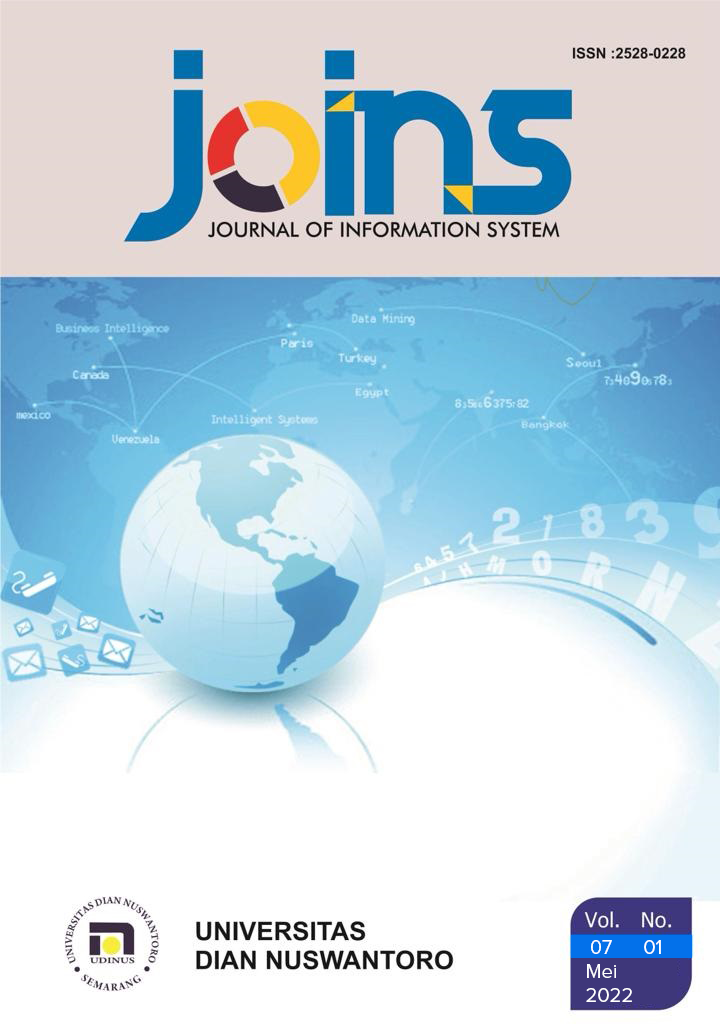Peningkatan Usability Point of Sales (PoS) Berbasis Human Centered Design (HCD)
DOI:
https://doi.org/10.33633/joins.v7i1.5528Abstract
Dalam perkembangan teknologi transaksi online hingga fasilitas e-commerce, sistem point-of-sale (POS) menjadi sangat populer karena menyediakan cara transaksi yang cepat dan nyaman untuk bisnis. Sistem ini mampu mengakomodasi tugas-tugas vital seperti transaksi online, keamanan, integrasi dengan perpajakan, hingga laporan manajemen. Oleh karena itu, menjadi penting dalam memastikan kualitas perangkat lunak dan pemanfaatan fungsi bisnis yang efektif. Di antara beberapa fungsi dan atribut kualitas perangkat lunak, sifat kegunaan perangkat lunak POS sangatlah krusial, karena antarmuka pengguna secara langsung sangat terkait dengan perilaku kasir, kepuasan pelanggan, dan keuntungan pasar. Namun, pelaksanaan evaluasi kegunaan sistem transaksi yang menggunakan teknologi POS tidak mudah karena secara umum ditampilkan banyak konfigurasi, dan antarmuka yang kompleks. Banyak model kualitas yang tersedia belum cukup untuk mengevaluasi kegunaan sistem POS yang hanya mencakup sebagian tampilan fungsinya.Dalam penelitian ini, kami melakukan investigasi sepuluh model kualitas dari metode System Usability Scale (SUS) dan mengekstrak faktor terkait kegunaan dari masing-masing model dan mengimplementasikannya berbasis desain yang berfokus pada manusia atau Human Centered Design (HCD). Evaluasi dari penggunaan aplikasi POS yang dibuat menghasilkan nilai rata-rata skor SUS sebesar 78,2 yang menunjukkan tingkat penerimaan masuk kategori Baik (Good).References
W. C. Davis And Z. J. Wang, “A Mobile Retail Pos,” In Proceedings Of The 2015 Workshop On Mobile Big Data, Jun. 2015, Pp. 49–51. Doi: 10.1145/2757384.2757391.
A. Hermanto, A. K. Darmawan, E. Sadewa, And Y. Wrahatnala, “Perbaikan Manajemen Proses Perangkat Lunak Berbasis Web Menggunakan Pemodelan Wspim,” 2019.
A. Fernandez, E. Insfran, And S. Abrahão, “Usability Evaluation Methods For The Web: A Systematic Mapping Study,” Information And Software Technology, Vol. 53, No. 8, Pp. 789–817, Aug. 2011, Doi: 10.1016/J.Infsof.2011.02.007.
N. Bornoe And J. Stage, “Lncs 8742 - Usability Engineering In The Wild: How Do Practitioners Integrate Usability Engineering In Software Development?,” 2014.
W. A. Staples And R. A. Swerdlow, “Evaluation Of Point-Of-Sale Services: Problems And Prospects For Retailing,” In Marketing Horizons: A 1980’s Perspective, Cham: Springer International Publishing, 2015, Pp. 324–324. Doi: 10.1007/978-3-319-10966-4_77.
A. Tri, R. Dewi, A. Hermanto, A. Bimo Gumelar, A. Widodo, And M. T. Sulistyono, “Pengembangan Aplikasi Indeks Pengukuran Kinerja Pada Institusi Pendidikan Tinggi Menggunakan Framework It Infrastructure Library (Itil),” Journal Of Information System, Vol. 6, No. 2, Pp. 181–189, Doi: 10.33633/Joins.V6i2.4552.
P. C. R. Len Bass, Software Architecture In Practice, Third Edition. Addisonwesley, 2020.
J. Nielsen, “Usability 101: Introduction To Usability,” 2012, Accessed: Dec. 09, 2021. [Online]. Available: Https://Www.Nngroup.Com/Articles/Usability- 101-Introduction-To-Usability/
J. And S. K. I. And W. E. D. Sugihartono, “Pembuatan Aplikasi Point Of Sale Toko Cabang Perusahaan Torani Menggunakan Framework Codeigniter,” J. Teknol. Dan Sist. Kompute, Vol. 3, Pp. 445–455, 2015.
R. A. Majid, N. L. M. Noor, And W. A. W. Adnan, “Theoretical Perspectives Of The Hcd Integration In Software Development Process,” Indonesian Journal Of Electrical Engineering And Computer Science, Vol. 17, No. 2, Pp. 1091–1095, 2019, Doi: 10.11591/Ijeecs.V17.I2.Pp1091-1095.
D. E. T. Sembodo, “Pembangunan Aplikasi Sistem Informasi Point Of Sales Pada Kedai Makan,” 2017.
N Babich, “Prototyping 101: The Difference Between Low-Fidelity And High-Fidelity Prototypes And When To Use Each,” Vol. 26, 2017.
A. Satrio Bagaskoro, R. Fauzi, And N. Ambarsari, “Perancangan User Interface Berdasarkan User Experience Aplikasi E-Learning Dengan Menggunakan Metode User-Centered Design Untuk Mendukung Proses Pembelajaran Studi Kasus : Sma Santa Maria 3 Cimahi User Interface Design Based On User Experience Of E-Learning Applications Using User-Centered Design Method To Support Learning Process Case Study: Sma Santa Maria 3 Cimahi.”
Downloads
Published
How to Cite
Issue
Section
License
Authors who publish with this journal agree to the following terms:
- Authors retain copyright and grant the journal right of first publication with the work simultaneously licensed under a Creative Commons Attribution License that allows others to share the work with an acknowledgement of the work's authorship and initial publication in this journal.
- Authors are able to enter into separate, additional contractual arrangements for the non-exclusive distribution of the journal's published version of the work (e.g., post it to an institutional repository or publish it in a book), with an acknowledgement of its initial publication in this journal.
- Authors are permitted and encouraged to post their work online (e.g., in institutional repositories or on their website) prior to and during the submission process, as it can lead to productive exchanges, as well as earlier and greater citation of published work (See The Effect of Open Access).

This work is licensed under a Creative Commons Attribution 4.0 International License.






















